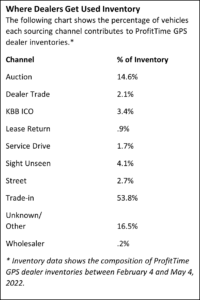A Closer Look at Where Dealers Can Acquire Late Model Vehicles More Profitably
If you’re a franchised dealer looking to stock more one- to three-year-old vehicles in your used vehicle inventory, you’re probably having a hard time lately.
The difficulty owes to a few related factors. First, there are fewer one-to-three-year-old vehicles available. In two of the three most recent years, 2020 and 2021,  new vehicle production fell markedly below normal levels. That’s not saying late model vehicles aren’t available. The pool is simply smaller.
new vehicle production fell markedly below normal levels. That’s not saying late model vehicles aren’t available. The pool is simply smaller.
Second, demand among dealers for one-to-three-year-old vehicles is as robust as ever. For much of the past decade, one-to-three-year-old vehicles have effectively served as the sweet spot in used vehicles for dealers. The cars are prime candidates for factory certified pre-owned programs, and they also appeal to buyers who, due to availability, budget or some other factor, want an almost-new used vehicle.
Third, wholesale values for one-to-three-year-old vehicles are sky high. In the past week or so, these vehicles are selling at auction for more than their current retail prices. Earlier this week, Cox Automotive analysts noted that 2019 vehicles, as a whole, sold at auction more than $50 above current retail prices.
Given this backdrop, I’ve asking a question: Where’s the opportunity?
I found at least a partial answer through inventory acquisition data from ProfitTime GPS dealers. The data comes from the solution’s Global Acquisition System, which helps dealers know the number/type of vehicles they source from specific channels (e.g., auctions, trade-ins, lease returns, service drives, etc.), the average investment value of vehicles in each channel, retail performance of cars in each channel, appraiser performance in each channel and other operational insights.
Generally speaking, the ProfitTime GPS dealers are like everyone else. They’re getting most of their one-to-three-year-old vehicles from the sourcing channels they’ve relied on for years. The data shows that 46 percent of vehicles less than five years old in dealer inventories come from trade-ins, and 19 percent come from auctions.
As you might expect, the profit potential these vehicles are able to produce is dramatically different. With trade-ins that are less than five years old, 36 percent arrive in dealer inventories as “Gold” vehicles and 18 percent are “Platinum.” (ProfitTime GPS ranks the investment value of each vehicle on a scale of 1-12, classifying them progressively as Bronze, Silver, Gold or Platinum vehicles.) Meanwhile, auction vehicles that are less than five years old consistently enter dealer inventories as Bronze (63 percent) and Silver (20 percent) vehicles, which represent the lowest investment values on ProfitTime GPS’ scale.
This data leads to another question—what other sourcing channels might offer dealers the opportunity to bring in more late model vehicles with better overall investment value potential?
To answer the question, I looked at inventory data to determine other sourcing channels where current volume and investment values suggest an opportunity. Some might readily point to lease returns as a solid option for dealers to get near-new inventory. The supposition is true—dealers take in almost 70 percent of lease returns as Gold and Platinum vehicles. However, lease return volume amounts to less than 1 percent of dealers’ total inventories, and current conditions see many lease owners choosing to keep their vehicles.
Meanwhile, there’s another sourcing channel that stands out as offering what might be regarded as untapped potential for late model inventory—the service drive. ProfitTime GPS dealers currently source about 2 percent of their used vehicle inventory from the service drive. When they bring in these vehicles, the profit potential on late model units runs strikingly close to trade-ins—35 percent are Gold and 20 percent are Platinum. This data affirms a comment I’ve heard from more than one ProfitTime GPS dealer: “There’s gold in your service drive if you go after it.”
As I’ve talked to dealers, most acknowledge that there’s ample room for improvement in the way they source from their service drives. Many have made this sourcing channel a higher priority this year. I’ve been collecting best practices for service drive sourcing, which I’ll share in a future post.
In the meantime, my quick study of dealer inventory data offers a key take-away for every dealer: Once you know the investment value and type of vehicles you might expect from individual sourcing channels, the better able you’ll be to profitably acquire the cars you really need to sell and satisfy today’s near-new-minded buyers.
